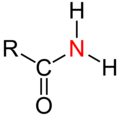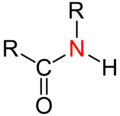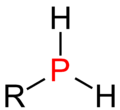Quartär (Chemie)
| Rot markierte Zentralatome in verschiedenen Stoffgruppen. Vergleich von quartären mit primären, sekundären und tertiären Zentralatomen. | ||||
| primär | sekundär | tertiär | quartär | |
| Kohlenstoffatom einer organischen Verbindung |

|

|

|

|
| Alkohol | 
|

|

|
existiert nicht |
| Amin | 
|

|

|
 (siehe QAV) |
| Carbonsäureamid | 
|

|

|
existiert nicht |
| Phosphin | 
|

|

|
 (siehe QPV) |
In der organischen Chemie ist das Wort „quartär“ eine Bezeichnung für vier an ein Zentralatom[1] (Kohlenstoff, Stickstoff, Phosphor) gebundene organische Reste (Organyl-Rest, wie Alkyl-Rest, Alkenyl-Rest, Aryl-Rest, Alkylaryl-Rest etc.).
Beispiele für quartäre Zentralatome
- ein Kohlenstoffatom in einem Alkan, an das vier Substituenten jedoch kein Wasserstoffatom gebunden ist,
- ein Stickstoffatom in einem quarternären Ammoniumsalz,[2] an das vier Kohlenstoffatome gebunden sind oder
- ein Phosphoratom in einem quarternären Phosphoniumsalz, an das vier Kohlenstoffatome gebunden sind.
Beispiele für solche Verbindungen ist das Alkan Neopentan (2,2-Dimethylpropan) mit dem quartären Kohlenstoffatom in der Mitte, das quarternäre Ammoniumsalz Tetramethylammoniumbromid und das quarternäre Phosphoniumsalz Tetramethylphosphoniumbromid.